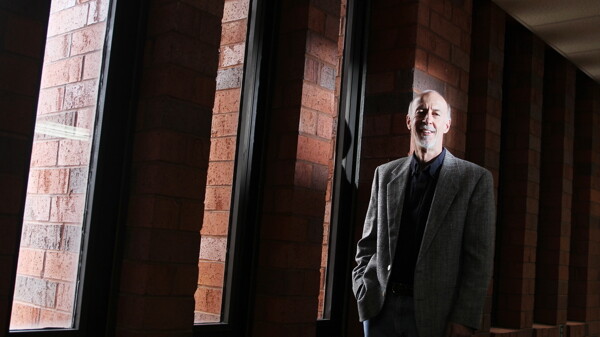The Sound of Words
Jack Bushnell releases fourth children’s book
Ken Szymanski, photos by Andrea Paulseth

Not many authors can say they learned the art of storytelling from a biology professor, but that’s how it worked for UWEC English professor Jack Bushnell. The biology professor who introduced Bushnell to the rhythm of words happened to be his father. “My father read to us for a long time growing up,” Bushnell said during a recent interview on the UWEC campus. “Even in junior high, I think he still read to us. So I grew up with a strong sense of the sound of words.”
In Bushnell’s latest book, Night of the White Deer (Tanglewood Press), it’s the sound of the words that lifts the story off the page. The picture book—about a farm boy visited by an albino deer with supernatural qualities—is “almost more like a prose-poem,” Bushnell says. Though he’s previously published three other books for young readers, two of which were picture books, this one may be the most lyrical of the bunch.
“When the crops first came up, there was bright new corn, new soybeans coming up – a carpet background of green. And this albino deer came across the distance and it just looked magical.” – UWEC English professor Jack Bushnell on the inspiration
for his book
Inspiration for the story struck years ago, when Bushnell lived in a farmhouse outside of Eleva. “We were surrounded by crop fields,” he says. “You could see forever in all different directions. When the crops first came up, there was bright new corn, new soybeans coming up – a carpet background of green. And this albino deer came across the distance and it just looked magical across the green carpet. It really glowed.”
Sensing a writing opportunity, Bushnell went to his computer, typed the first two sentences of the story, and saved it for later—much later. Those two sentences sat untouched on his computer for over a year.
Prying the rest of the story loose came at another story’s expense. He had been researching the aurora borealis for a nonfiction piece, but the publisher canceled the project. Bushnell was initially frustrated with the time he’d invested in the research, until he came up with a new idea: What if the albino deer story and the aurora borealis were connected? With the idea of this deer taking a farm boy through the northern lights, the rest of the story was born.
“(After that), it was the quickest of all my books,” Bushnell says. “I wrote the rest of it in a few weeks.” He added a father-son relationship to the story, thinking of his own father often during the writing process. Bushnell had dedicated the book to his parents but, in a sad turn of events, his father passed away before the book came out.
“He would’ve loved it, I think.” Bushnell says. “He was always supportive and encouraging, but I wasn’t sure—deep down—what he thought about the fact that I was writing books for children. But he was very happy to hear I sold it and that it was coming out.”
Bushnell does his share of so-called “serious” writing for adults, publishing numerous essays in national literary journals and regional publications. He says that writing for children actually presents an extra challenge. “You have to appeal to kids, but at the same time,” he says, “you have to appeal to adults because they’re often the ones reading the story. So it has to be a damn good story.”
He also believes in E.B. White’s advice that authors shouldn’t write down to kids—instead, they should write up to them. “I tell my students that a picture book can’t have its feet planted too firmly on the ground,” Bushnell says. “It needs to rise off the ground a little bit.”
That’s all the more reason, then, to send a boy and a deer sailing through the northern lights—where science can still hold the mystery of a story.

